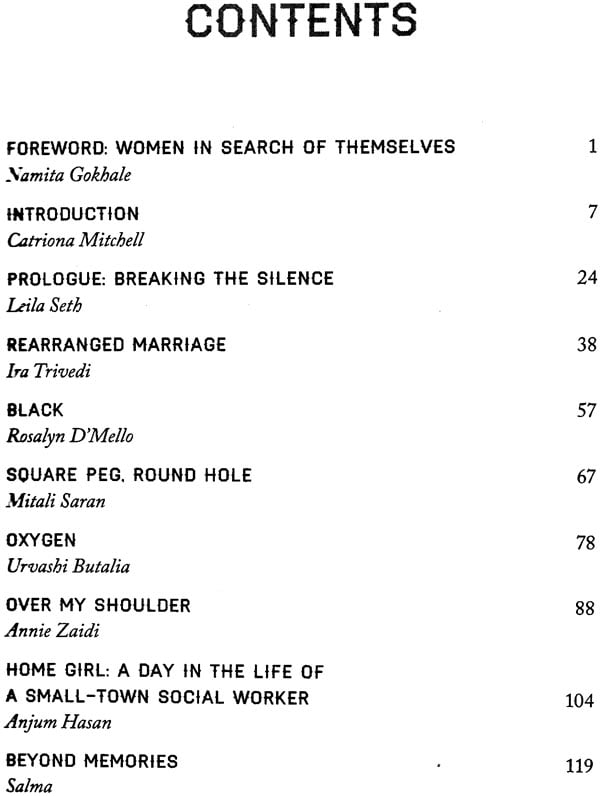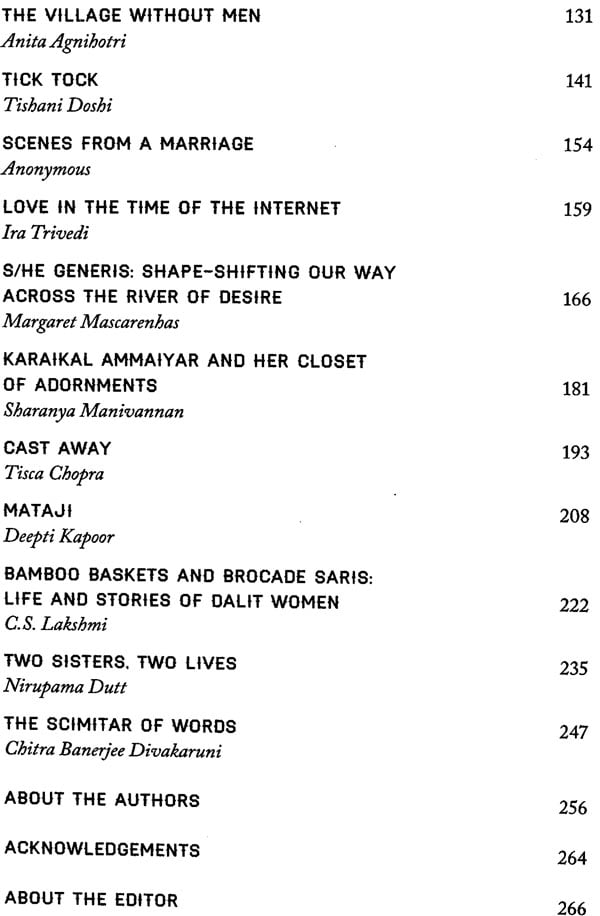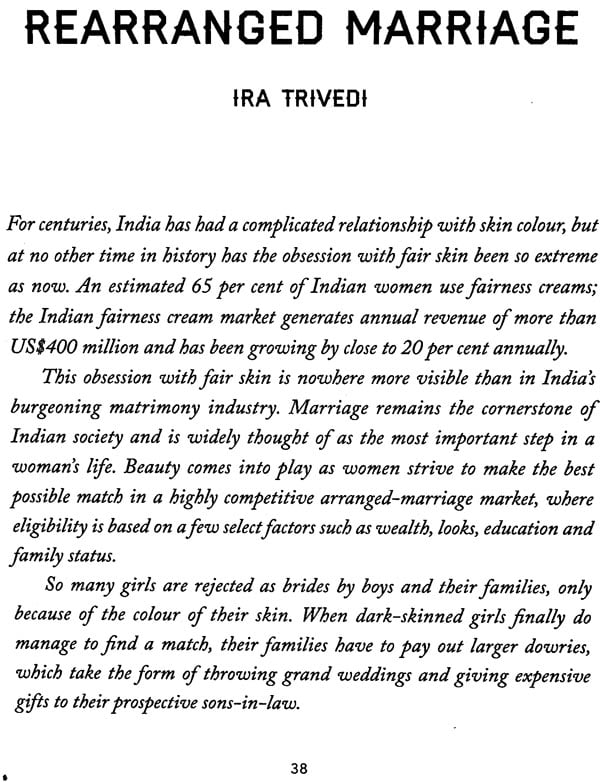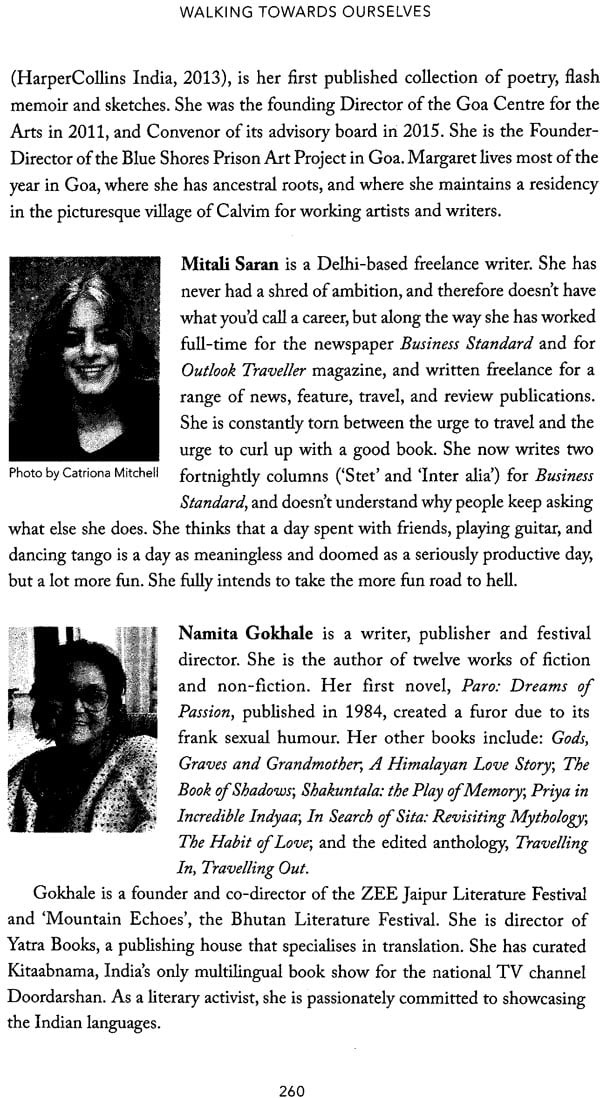
Walking Towards Ourselves: Indian Women Tell Their Stories
Book Specification
| Item Code: | NAQ460 |
| Author: | Catriona Mitchell |
| Publisher: | Harper Collins Publishers |
| Language: | English |
| Edition: | 2016 |
| ISBN: | 9789351777922 |
| Pages: | 270 |
| Cover: | PAPERBACK |
| Other Details | 8.50 X 5.50 inch |
| Weight | 200 gm |
Book Description
Walk with them as they report from Mumbai's streets alone at night, as they grapple with domestic violence, as they search for love through marriage brokers, as they learn to speak their minds, as they lay claim to their bodies, as they choose to be partnered or not, to become mothers or not, to make art, to make love, to make meaning of their lives.
Reaching across different strata of society, religion and language, this anthology creates a kaleidoscope of distinct and varied real-life stories. Told with startling honesty, piercing insight, moments of poetry, and flashes of humor, Walking towards Ourselves is a timely exploration of what it means to be a woman in India in a time of intense and incredible change.
NAMITA GOKHALE
As a writer, publisher and festival director, there are various journeys I have made across my life. Through yatras and parikramas and pilgrimages, I have tried to make sense of my world and find patterns of meaning within it. Through writing and publishing books, through literary events, through the lived life which is the raw material of it all, it has taken me some time to accept that I am woman writer.
When my debut novel Paro: Dreams of Passion was published in 1984, it subjected me to the shocked outrage of Indian readers who could not believe that a bona-fide Indian woman had so flagrantly crossed the line of propriety. I had thought of it as a comic novel and was surprised by the outrage; it's a relief that different generations of readers have found it funny for over thirty years now.
It's been a long journey, a stumbling quest across twelve books, and another I am currently working on. I have at last come to terms with being a woman - an Indian woman - whatever that might imply.
I am a writer, I am a woman. Yet, as writers, we are more than the sum of our sex, gender and biology. As writers we are constantly trying to enter the minds and skins and situations of all the people we write about, be they men, women, both, or neither. And yet there is a critical mass of womanhood inside many of us - an aggregate of hurts, rejections and assertions - that we don't want to leave behind; that we do, in fact, wish to address as writers.
The life of a woman is an interior life; it is spent in daily tasks, it follows the rhythm of the seasons, and, usually, it ends and passes without record.
One of my books, Mountain Echoes: Reminiscences of Kumaoni Women, compiled oral biographies of my grandmother and three grand-aunts, all four highly individualistic, vibrant and feisty women. My family roots are in Uttarakhand, in the mountains around Nainital and Almora. In the dedication I observed, 'In our mountains women are rarely afraid. They are strong, direct, loyal, and in most situations they are free to speak their minds. You see them roaming the forests for fodder, strong-footed as goats, fearless as lions. They are not afraid of the dark and they brave the cold, they ford the swift mountain streams sure-footedly and when they are surprised by an attacking tiger, they have been known to raise their scythes and give chase to save a savaged sister from a man-eating predator.'
When I began recording the lives of my grandmother and grand-aunts, and the lives of their mothers before them, I encountered a moving personal strength and a disturbing social vulnerability. I observed, 'The history of women is left to us in folklore and tradition, in faintly remembered lullabies and the half-forgotten touch of a grandmother's hand; in recipes, ancestral jewellery, and cautionary tales about the limits of a woman's empowerment.'
As a writer, my interests moved to mythology and its living manifestations in India. Four books, The Book of Shiva, The Mahabharata for Young Readers, Shakuntala: The Play of Memory and In Search of Sita: Revisiting Mythology, emerged from this quest. I learnt a lot from The Mahabharata. Unlike in The Ramayana, the women of this vast epic negotiated their lives outside as well as inside domestic spaces. Be it Kunti, Draupadi or Hidimba, Amba, Ambika or Ambilika, queen, demoness or transgender, these women demanded agency and lived life resolutely on their own terms. As a child, I had been told that The Mahabharata was not to be kept at home, or read by women, as this would cause discord. I realize now that this injunction was born of patriarchal caution, that the self-willed strength of these epic women was not a role model the men wanted emulated. The mythological figure of Sita stands as an archetype for most Indian women. Mythology is not an academic area of study in India but a part of a living cultural continuity. The gods and goddesses are alive here and we encounter them at every stage and step of daily life.
Indian women fill up a large space in the map of humankind. There are approximately 623 million of us - approximately 8.6 per cent of the human species. The stories of our lives, and the contexts and circumstances within which we negotiate our womanhood and self-hood, are as diverse and varied as India herself. As a nation and a culture, India remains a paradox and an enigma, replete with contra-dictions. India is a land where women are worshipped as goddesses, yet barbaric practices such as sati and child marriage continue to exert their hold into the twenty-first century. It has had a woman prime minister and president, and women excel and exert influence in professions such as politics and law, the administrative services, media, literature, medicine and banking. But the real strength of Indian women, those unsung heroines who hold up more than half the sky, comes from the disadvantaged, the indigent and marginalized, the often-silenced majorities who till the soil, graze their cattle, work in
Last time I was leaving Delhi, my flight home to Australia was scheduled for 2 am. Being someone who travels a lot and at odd hours, it didn't occur to me that this might be a problem until the date arrived and I realized I would need to cross the city at midnight. Lack of safety for women in Delhi had been a focus in the international press for at least two years. In the absence of a driver with whom I was familiar, and with the safety of Uber under question at the time because of a sexual assault by one of its Delhi drivers the previous month, I felt a growing sense of vulnerability - especially as darkness descended and a night fog started to envelop the neighborhood.
Then I remembered an article I had come across a few days earlier, which was about an N.G.O. that had set up an all-female taxi company. It sought out unemployed women from the city's poorest parts, taught them to drive and to read maps, gave them training in assertiveness, self-defense and communication skills, put them in uniform, and paid them a wage so decent that even the most resistant in their community were supportive of their employ.
I made the phone call.
The taxi arrived just after midnight, making its way slowly down the laneway to where I stood waiting with my suitcase in the dark. I could barely see the driver above the steering wheel, she was so slight. She was young, too: barely over twenty. She smiled as I clambered in with my case and introduced herself as Deeply. It seemed to me her smile carried enough voltage to light up the whole city.
There were few other cars on the road, but a stream of trucks passed us at speed down the Aurobindo Marg and the night air was thick with dust in their wake. There was no one else outside at this hour. At the lights, the truck drivers were able to stare from their cabins into our car. On seeing the two of us alone in the taxi, there was leering, and jeering. I pulled a scarf over my blonde hair and glanced at the safety lock of the car to see that it was pushed down. Deepali focused her attention on the road ahead, giving no indication that she was even aware of their presence; she started to peel some of the burgundy varnish off her chipped fingernails.
A barrage of questions was forming in my mind: Does this happen often? When you're alone, too? Do you feel protected, with just the safety lock of the car standing between you and them? What happens if someone attacks you? Whom can you call? What happens when you need to refuel the car? Where do you go to the toilet? What does your father think about your being out on these streets through the night? How old are you, anyway?
In the end, I settled for: 'Do you like your job?' To which Deepali replied: 'I don't know.'
She drove on in a focused, pensive way to the airport, as if the force of her concentration alone would keep her safe.
From the reassuringly bright lights at the airport's drop-off point, I watched Deepali's taxi edge back into the stream of traffic, re-entering the dark and smog and fog of that winter night. I feared for what lay ahead of her until the dawn broke, and marveled at her youth and courage. I felt ashamed that this journey would stand out in memory for me - an Australian visitor to India - for being subversive and a little frightening, something I wouldn't repeat if I could help it, whereas for Deepali, this was her daily, or rather nightly, reality.
The international press regularly tells us that India is one of the most dangerous places on the planet to be a woman.
When at home in Australia, I am vocal about my love for India to the point of obsession, and this sparks what has become a rather predictable pattern of conversation. Women in my country are constantly telling me that they're eager to visit India, but don't dare, for fear that they might be attacked. The question they want me to answer for them is: If Igo there, will I be safe?
Meanwhile, Indians from Jaipur to Bangalore to Cochin to Pondicherry have asked me the same question about visiting Australia. This was true particularly in the wake of the shocking murder of an Indian student in Melbourne in 2010, and other race-motivated crimes against young Indians in Australia around that time, but the questioning continues to this day: If Igo there, wil 1 I be safe?
In December 2012, when a young medical student was returning home after an evening screening of Life of Pi in a mall in South Delhi,
Book's Contents and Sample Pages











